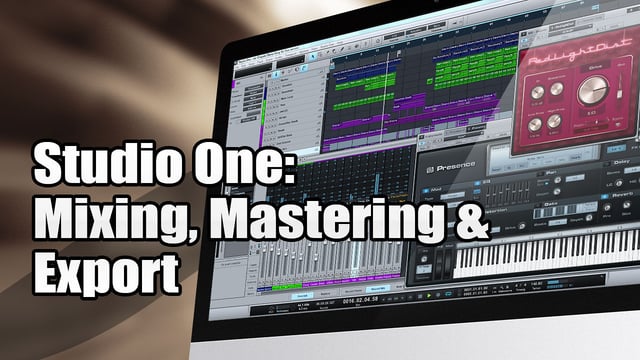

This is a premium product and you will get it free on here.
Studio one mastering download#
This avoids the bassier parts of, say, a keyboard sound, clashing with the more vital bass from a bass guitar.This Asset we are sharing with you the Skillshare Mixing and Mastering Masterclass using Studio One Lesson 1 free download links. As a general rule you’ll want to roll the bass off of most of the parts bar the actual bass sounds, unless you have a bass-less mix. As with panning you are trying to fill the space, but this time it’s the frequency range rather than the stereo spread. We then move onto EQ and demonstrate how this can accentuate certain sounds in the mix without needing to drive their levels. Do the same with backing vocals and make sure the main vocal can be heard above them. Keep clashing parts, like those two acoustic guitar parts, away from each other in this way by panning one left and one right. Panning is the next dimension to explore, and here you tend to leave the main vocal and all of the bassier parts in the middle and spread everything else. DAWs are great at presenting your mixes back to you in all of those colours we chose last time around, but it’s best to mix with your ears more than your eyes, so feel free to turn your computer monitor off once in a while and just listen very carefully. But do listen, rather than constantly look. Within your DAW keep levels peaking at -6dB and, perhaps obviously, keep everything out of the red. And always take regular breaks, as listening to the same track over and over can make you tired in the brain as well as the ears. By all means have an occasional blast, but generally keeping things low is good. You might end up mixing for very long sessions, so you’ll want to monitor at low levels to give your ears a rest. We’ll start by looking at levels and our advice when mixing is to pull everything back, and that means your monitor/speaker levels too. Then we move on to EQ to fill the dynamic range with clear basses and shimmering trebles. Then it’s onto panning to move things around the stereo spectrum and fill that space between speakers.

Mixing is all about letting your music breathe in these dimensions, so first of all you adjust the levels to try and allow everything to be heard.
Studio one mastering full#
By getting levels right, spreading the music out correctly in the stereo spectrum and adding depth with EQ, you should end up with a great-sounding track with a full dynamic one that uses every space in almost three sonic dimensions.


Studio one mastering pro#
You can read more about how we put this piece together in our Studio One tutorial series at but the reality is that by following this tutorial, you should be able to apply some mixing principles to whatever music you are making, so feel free to load in your own tunes and follow our advice to get a professional mix.Īnd the mix process really does add this pro sheen. We already have a tune and have arranged it roughly for this tutorial. This DAW really has come of age and many people are starting to use it, thanks to its slick GUI, dozens of included instruments and effects and its high-quality, professional-level features. We’ll also use the opportunity to explore some of Presonus Studio One 4’s great features for mixing.


 0 kommentar(er)
0 kommentar(er)
